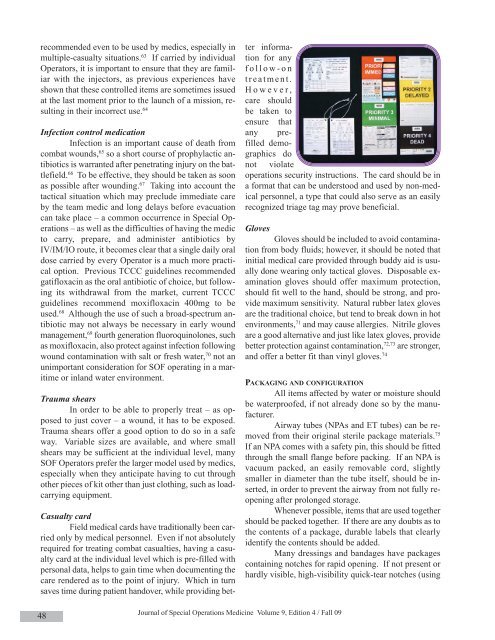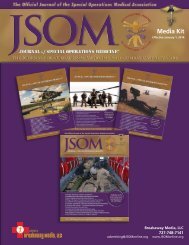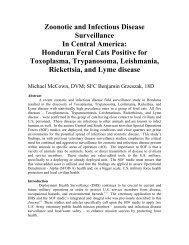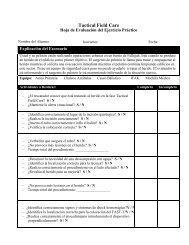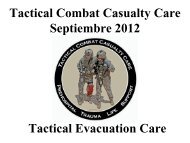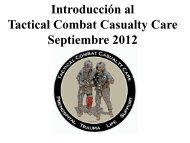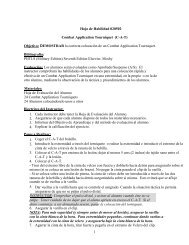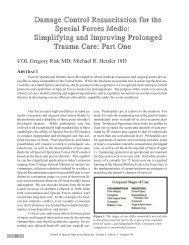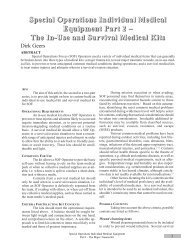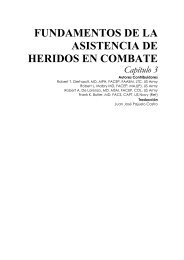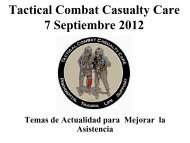Part One - The Major Trauma Kit. 09(4). - Journal of Special ...
Part One - The Major Trauma Kit. 09(4). - Journal of Special ...
Part One - The Major Trauma Kit. 09(4). - Journal of Special ...
You also want an ePaper? Increase the reach of your titles
YUMPU automatically turns print PDFs into web optimized ePapers that Google loves.
ecommended even to be used by medics, especially in<br />
multiple-casualty situations. 63 If carried by individual<br />
Operators, it is important to ensure that they are familiar<br />
with the injectors, as previous experiences have<br />
shown that these controlled items are sometimes issued<br />
at the last moment prior to the launch <strong>of</strong> a mission, resulting<br />
in their incorrect use. 64<br />
Infection control medication<br />
Infection is an important cause <strong>of</strong> death from<br />
combat wounds, 65 so a short course <strong>of</strong> prophylactic antibiotics<br />
is warranted after penetrating injury on the battlefield.<br />
66 To be effective, they should be taken as soon<br />
as possible after wounding. 67 Taking into account the<br />
tactical situation which may preclude immediate care<br />
by the team medic and long delays before evacuation<br />
can take place – a common occurrence in <strong>Special</strong> Operations<br />
– as well as the difficulties <strong>of</strong> having the medic<br />
to carry, prepare, and administer antibiotics by<br />
IV/IM/IO route, it becomes clear that a single daily oral<br />
dose carried by every Operator is a much more practical<br />
option. Previous TCCC guidelines recommended<br />
gatifloxacin as the oral antibiotic <strong>of</strong> choice, but following<br />
its withdrawal from the market, current TCCC<br />
guidelines recommend moxifloxacin 400mg to be<br />
used. 68 Although the use <strong>of</strong> such a broad-spectrum antibiotic<br />
may not always be necessary in early wound<br />
management, 69 fourth generation fluoroquinolones, such<br />
as moxifloxacin, also protect against infection following<br />
wound contamination with salt or fresh water, 70 not an<br />
unimportant consideration for SOF operating in a maritime<br />
or inland water environment.<br />
<strong>Trauma</strong> shears<br />
In order to be able to properly treat – as opposed<br />
to just cover – a wound, it has to be exposed.<br />
<strong>Trauma</strong> shears <strong>of</strong>fer a good option to do so in a safe<br />
way. Variable sizes are available, and where small<br />
shears may be sufficient at the individual level, many<br />
SOF Operators prefer the larger model used by medics,<br />
especially when they anticipate having to cut through<br />
other pieces <strong>of</strong> kit other than just clothing, such as loadcarrying<br />
equipment.<br />
Casualty card<br />
Field medical cards have traditionally been carried<br />
only by medical personnel. Even if not absolutely<br />
required for treating combat casualties, having a casualty<br />
card at the individual level which is pre-filled with<br />
personal data, helps to gain time when documenting the<br />
care rendered as to the point <strong>of</strong> injury. Which in turn<br />
saves time during patient handover, while providing better<br />
information<br />
for any<br />
f o l l o w - o n<br />
t r e a t m e n t .<br />
H o w e v e r ,<br />
care should<br />
be taken to<br />
ensure that<br />
any prefilled<br />
demographics<br />
do<br />
not violate<br />
operations security instructions. <strong>The</strong> card should be in<br />
a format that can be understood and used by non-medical<br />
personnel, a type that could also serve as an easily<br />
recognized triage tag may prove beneficial.<br />
Gloves<br />
Gloves should be included to avoid contamination<br />
from body fluids; however, it should be noted that<br />
initial medical care provided through buddy aid is usually<br />
done wearing only tactical gloves. Disposable examination<br />
gloves should <strong>of</strong>fer maximum protection,<br />
should fit well to the hand, should be strong, and provide<br />
maximum sensitivity. Natural rubber latex gloves<br />
are the traditional choice, but tend to break down in hot<br />
environments, 71 and may cause allergies. Nitrile gloves<br />
are a good alternative and just like latex gloves, provide<br />
better protection against contamination, 72,73 are stronger,<br />
and <strong>of</strong>fer a better fit than vinyl gloves. 74<br />
PACKAGING AND CONFIGURATION<br />
All items affected by water or moisture should<br />
be waterpro<strong>of</strong>ed, if not already done so by the manufacturer.<br />
Airway tubes (NPAs and ET tubes) can be removed<br />
from their original sterile package materials. 75<br />
If an NPA comes with a safety pin, this should be fitted<br />
through the small flange before packing. If an NPA is<br />
vacuum packed, an easily removable cord, slightly<br />
smaller in diameter than the tube itself, should be inserted,<br />
in order to prevent the airway from not fully reopening<br />
after prolonged storage.<br />
Whenever possible, items that are used together<br />
should be packed together. If there are any doubts as to<br />
the contents <strong>of</strong> a package, durable labels that clearly<br />
identify the contents should be added.<br />
Many dressings and bandages have packages<br />
containing notches for rapid opening. If not present or<br />
hardly visible, high-visibility quick-tear notches (using<br />
48<br />
<strong>Journal</strong> <strong>of</strong> <strong>Special</strong> Operations Medicine Volume 9, Edition 4 / Fall <strong>09</strong>


